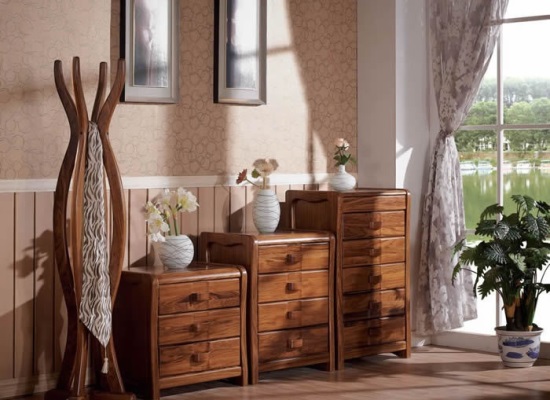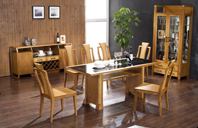Europe wooden furniture market reports
Source:globalwood.org
There was a robust rebound in EU wooden furniture production and trade in 2014 and 2015. As noted in earlier ITTO reports, wooden furniture production value in the EU (excluding kitchen furniture) was euro 31.15 billion in 2015, 4.4% more than 2014 and nearly 9% up on 2013, with gains made in all the main EU manufacturing countries.

Asian wooden furniture manufacturers losing share in European market
There was a robust rebound in EU wooden furniture production and trade in 2014 and 2015. As noted in earlier ITTO reports, wooden furniture production value in the EU (excluding kitchen furniture) was euro 31.15 billion in 2015, 4.4% more than 2014 and nearly 9% up on 2013, with gains made in all the main EU manufacturing countries.
EU imports of wooden furniture from outside the EU were worth euro 5.73 billion in 2015, 13% more than the previous year and 25% up on 2013. EU exports of wooden furniture rose to euro 8.73 billion in 2015, up 3.5% from 2014 and 6% more than in 2009.
While no EU furniture production data for 2016 has yet been published, early signs are that production has continued to rise this year even while external trade with non-EU countries has declined. In other words, European manufacturers are taking a larger share of the internal EU market in 2016, squeezing out overseas competitors at home as their efforts to expand sales to non-EU countries are beginning stall.
Eurostat data shows that the value of wooden furniture exports by EU countries to other countries within the EU was euro 8.16 billion in the first half of 2016, 7.3% more than the same period in 2015. In contrast, the value of exports to countries outside the EU declined 1% to euro 4.16 billion in the first half of 2016.
The slowdown in EU exports this year is mainly due to a 30% decline in exports to Russia. EU exports to other countries continue to rise.
Meanwhile external suppliers of wood furniture, particularly in the tropics, seem to be struggling in what has become an extremely competitive market. The EU imported wooden furniture with a total value of euro 2.97 billion in the first six months of 2016, 2% less than the same period in 2015.
After making significant gains in the EU market in 2015, EU wooden furniture imports from China and tropical countries have slipped back this year. In the first six months of 2016, import value from China declined 7% to euro 1.51 billion and import value from tropical countries declined 1% to euro 930 million.
However, EU import value from non-EU temperate countries increased by 16% to euro 528 million, with particularly large gains by Turkey, Bosnia and Serbia.
EU import value of wooden furniture declined from all of the largest South East Asian suppliers in the first six months of 2016.
The value of EU import from Vietnan declined by 1.5% to euro 416 million, by 3.1% from Indonesia to euro 176 million, by 5.2% from Malaysia to euro 100 million, and by 8.8% from Thailand to euro 34 million.
However, there were gains in imports from India (+7% to euro87 million) and Brazil (+7% to euro 63 million).
Overall, the signs are that, unlike in North America, domestic manufacturers are maintaining and even extending their domination of the European wooden furniture market.
There are many reasons for this. An obvious short term factor is weakening of European currencies in the last 2 years – particularly the UK pound since Brexit - against the dollar and Chinese yuan.
More enduring factors include: the relative high degree of fragmentation in the European retailing sector – which greatly complicates market access for overseas suppliers; the underlying strength of European furniture manufacturers and their brands in terms of innovation and design; the obstacles to overseas suppliers complying with complex EU technical and environmental standards; and the expansion of furniture manufacturing in Eastern Europe, a location which combines ready access to raw materials, relatively cheap labour, and the internal EU market.
While it seems likely that domestic manufacturers will continue to dominate Europe’s wooden furniture market in the years ahead, there are significant changes underway which are altering the terms of trade. While some changes are likely to create new obstacles for external suppliers, others may provide opportunities.
Two factors are particularly significant and explored in the following sections: the decision of the UK to leave the EU, so-called Brexit; and the strategy of IKEA, already a dominant force in the European market place, to increase their market share through a strategic focus on “sustainability” and all that implies for product design, material procurement, energy efficiency and waste management.
Brexit: far-reaching consequences for EU wooden furniture market
Brexit is particularly significant for the wooden furniture sector as the UK is the largest single EU destination for this commodity imported from outside the EU. In 2015, the UK accounted for 36% of all EU imports of wooden furniture from outside the single market.
This is due to the relatively high degree of consolidation in the UK’s furniture retailing sector compared to other EU countries, and the UK’s relatively high level of openness to foreign trade and products, comparatively small domestic furniture sector, and longer distances from the heartland of EU furniture manufacturing in Italy, Germany and Poland.
Fears of economic fallout from Brexit have led to an immediate and large devaluation of the British pound against other currencies. Throughout October, the pound has been trading at around US$1.22 against the dollar, the lowest level for 31 years and 18% less than just before the Brexit vote.
At times during the month the pound also dropped below the psychologically important euro 1.10 level against the euro, its lowest level since March 2010 and 15% less than before the vote.
After a year of strong growth in 2015, the UK’s imports of wooden furniture had levelled off at the higher level in the first half of 2016, prior to the Brexit vote.
UK imports from other EU countries and from China had declined slightly during this period, but were continuing to grow slowly from the main tropical suppliers including Vietnam, Malaysia, Brazil and Indonesia.
(Source: globalwood.org)





 沪公网安备31010402003309号
沪公网安备31010402003309号



